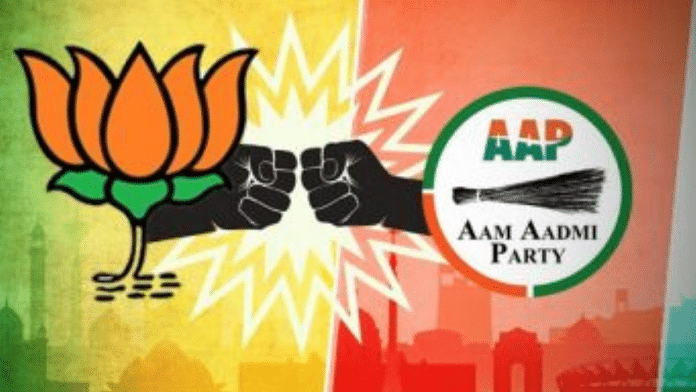Aam Aadmi Party has been at the forefront of the “battle of ideas in national politics”, positioning itself as a viable alternative to the ruling Bharatiya Janata Party. Within a decade, AAP has managed to infiltrate corners of the populist imagination across languages and federal borders, even challenging Prime Minister Narendra Modi and Union Home Minister Amit Shah in their home state.
A pragmatic perspective is required to comprehend the success of a barely decade old party in standing up to leaders emerging from the emergency. The role of social media in Indian political discourse has undeniably aided all parties, including AAP, in spreading their agendas and narratives. AAP stands out as at least one of the leading beneficiaries of internet culture, if not the winners of social battle of political ideas.
Understanding the use of memes and relevant cultural practices as trends has been at the forefront of narrative creation to understand the rise of populist parties, in this case AAP. Narratives strong enough to contest a rival as strong as the BJP.
AAP’s official date of foundation may be 2 October 2012, visionary leaders in the party created their official YouTube channel way back on 25 January 2011. The channel as of today has 1,584,691,806 views, slightly ahead of the BJP which stands at 1,254,087,995. The AAP figure above, however, only represents viewership for a single channel; other official channels named Arvind Kejriwal and various state-specific channels are also endorsed. This offers insight on how AAP uses its social media handles to capture the imagination of the youth.
It would be imprudent to deny that the BJP and other political parties are not using social media for the same purpose but what makes AAP stand out is its constant use of the memes across these platforms. The term, ‘meme’, coined by Richard Dawkins in his book The Selfish Gene as “a unit of culture”, has attempted to highlight the viral nature of these units in order to understand replications of human behaviour for survival apart from genes/DNA.
Also read: There’s a yoga war in Delhi parks between Arvind Kejriwal and L-G. Breathe in and keep calm
This exact usage can be witnessed in AAP’s political propaganda when it takes on a juggernaut like the BJP and its attempts to “crush” Arvind Kejriwal’s populist policies. Nicholas Humphrey, English neuropsychologist, explained, “memes should be regarded as living structures, not just metaphorically but technically. When you plant a fertile meme in my mind you literally parasitise my brain, turning it into a vehicle for the meme’s propagation in just the way that a virus may parasitise the genetic mechanism of a host cell.”
And this isn’t just a way of talking — the meme for, say, ‘belief in life after death’ is physically realised, millions of times over, as a structure in the nervous systems of individual men all over the world, helping the AAP in countering corruption narratives against its officials.
The party’s attempts to convert this vehicle of cultural narratives through populism are countering BJP’s populist agendas, which can be explained using the common phrase – iron cuts iron, in the same way populism counters populism. AAP’s populism, however, is complimented by using this adaptive nature of human cultural values called ‘memes’.The Punjab election can be considered an eminent example for the same.
These new e-tools may provide perceptional advantages to political campaigns in India’s democracy. Hence, it is critical to understand that Delhi, AAP’s home court advantage, which remains India’s largest internet user metropolitan, has consequences for internet users across India when AAP propagates its work in the capital as a model to be implemented in Pan-India. With AAP’s official channel propagating other channels focusing on specific leaders such as Kejriwal or Sanjay Singh, the BJP cyber cell must be aware of AAP’s circumspect internet strategy.
While both AAP and BJP appear to be at the extreme ends of their respective ideologies in the Indian political landscape (mostly north), pushing collectivist ideologies appears to be a common motivation. While AAP leaders may accuse the BJP of copying the same ideas and models of governance, majority vote share aspirations compel AAP to follow the same avenues. Thus, both parties used similar Dawkinian “units of culture” in order to propagate their aspirations.
The author is a student at Christ University, Bangalore. Views are personal.






